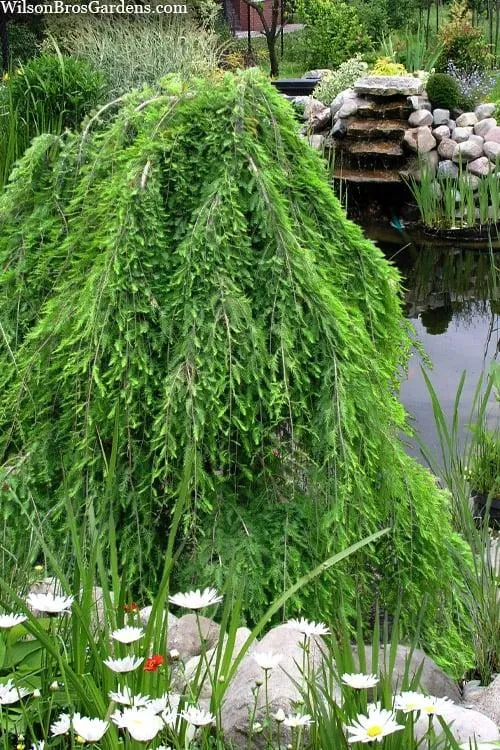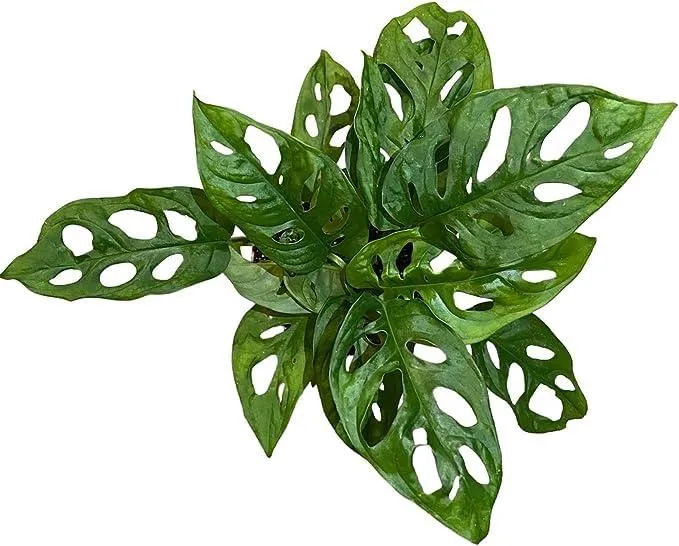Plants That Will Cascade Down and Trail Beautifully From Containers and Hanging Baskets
If you’re looking to add some lush foliage and flowery touches spilling over the edges of planters, containers, or hanging baskets, trailing and cascading plants are a gorgeous option. From my experience as a gardener, nothing dresses up a patio or deck like vines, creeping plants, and hanging flowers that can trail downwards gracefully. In this article, I’ll cover some of the best options to consider.
English Ivy
English ivy (Hedera helix) has to be one of the most widely used trailing plants. No wonder – it’s practically impossible to kill! Its thick, glossy leaves emerge in various shades of green and it stays compact, never getting woody. English ivy thrives in part shade and will bleed beautifully over the sides of any container. The good news is, it’s not actually invasive like some other ivies when grown in a pot. My grandmother always had a hanging basket overflowing with English ivy – brings back memories!
Trailing Petunias
For a burst of colorful flowers, you can’t beat petunias. Look for varieties labeled “trailing” – they’ll grow horizontally rather than upright. I find the multicolored “Surfinia” petunias put on a stunning display from spring to fall. Their small blooms come in vivid shades of pink, purple, red, orange and white. Petunias prefer full sun and are pretty drought tolerant once established. Pinch back the ends occasionally to encourage branching. If you’re seeking a low-maintenance cascade of flowers, trailing petunias are kind of a no-brainer.
Creeping Jenny
With its mounds of bright green, circular leaves, Lysimachia nummularia, aka Creeping Jenny, makes a lovely groundcover but also trails beautifully over the edges of hanging baskets and containers. I’ve used it as a spiller planted around the rims. It spreads via creeping stems, rooting as it goes. Creeping Jenny blooms yellow in summer. While it likes moisture, it’s fairly resilient and can handle afternoon shade. The foliage has a nice tracery-like texture. It’s a great option if you want vines with interesting foliage rather than flowers.

Fibrous Begonias
For lush, tropical-looking foliage cascades, consider fibrous begonias like ‘Nonstop.’ Their bold, chartreuse leaves have a shiny texture. In warmer zones, they’ll produce dainty pink flowers too. But the leaves are really the main attraction, in my opinion. Begonias want partial shade and consistently moist soil to look their best. So if shade is an issue for your space, english ivy may work better as a more resilient choice. But begonias sure do make a statement when happy!
Vinca Vine
Also called periwinkle or myrtle, the vinca vine (Catharanthus roseus) is prized for its dark green leaves and cheerful flowers ranging from white to rose-pink. It roots wherever its trailing stems contact the soil. Got zone 9 or above? This may be your plant – it ́s not fully frost-hardy. Vinca vine thrives in sun or partial shade with average to dry soil. I remember helping my grandma maintain her vinca bed every year, and those memories always put a smile on my face.
Purple Heart Tradescantia
With its trails of purple, arrowhead-shaped leaves, purple heart tradescantia or spiderwort (Tradescantia pallida) is a stunner. I think the variegated type ‘Purple Queen’ may be the showiest version. Fun fact – the leaves actually deepen to a rich eggplant hue with more sunlight. Spiderworts are fairly low maintenance bloomers bearing tiny, pale pink flowers in summer. They grow well in containers, hanging baskets or as a groundcover in partial shade. The purple foliage really makes a statement. Maybe not kid-safe though if ingested – y’know, just in case.
Fuchsia
For vibrantly coloredtrailing flowers, it’s hard to top fuchsias. But you have to give them sun and consistent moisture to keep them looking their best. A few popular trailing types include the compact ‘Gartenmeister Bonstedt’ with red and white flowers; deep rose ‘Swingtime’; and the single-flowered ‘Madonna’ which dangles coral blooms. Fuchsias will trail pleasantly over the edges of hanging baskets and planters, spilling a delightful assortment of blooms. If cared for properly, they can perform amazingly well, in my experience.

Million Bells
With its profusion of tiny pink, white or red blossoms, “million bells” or calandrinia (Calandrinia grandiflora) lives up to its name. The flowers really do create a blanket of color! This tender annual vine prefers full sun and well-draining soil. It may self-seed readily if happy. I used to grow million bells in my old deck planters – the flowering cascades looked stunning in spring and summer. Slightly fussy but very much worth the effort, in my opinion. A real show-stopper when it’s blooming.
Ivy Geranium
Not to be confused with regular geraniums, ivy geraniums (Pelargonium peltatum) have dark green, ivy-shaped leaves and fluttering flowers. The most commonly available types are ‘Carousel Dark Red’ with deep maroon blooms, and the bicolor ‘Carousel Orange’ with vibrant orange and white flowers. Ivy geraniums trail nicely and will bloom continuously from spring to fall. They also adapt well to partial shade. When I was young I remember my neighbor’s overflowing ivy geranium baskets – so cheerful and colorful against her white picket fence.
So in summary, whether you want vines, groundcovers, flowering creepers or foliage plants – there are lots of options for creating lush, cascading displays spilling from hanging baskets, raised planters and more. Hopefully these plant suggestions give you some great ideas to dress up your outdoor space beautifully! Let me know if any other plant questions come to mind.
Factors to Consider When Choosing Houseplants
| Plant | Light Needs | Water Needs | Care Level |
|---|---|---|---|
| Pothos | Low to Medium | Allow soil to dry between waterings | Low |
| Snake plant | Low | Water when top inch of soil is dry | Low |
| Succulents | Bright, indirect light | Water when soil is completely dry | Low |
| Peace lily | Medium | Water when top inch of soil is dry | Low to medium |
| Chinese evergreen | Medium to bright, indirect light | Water when top inch of soil is dry | Low to medium |
FAQ
-
What plants can grow downwards?
Plants that dangle or trail, basically. Things like pothos, English ivy, and wandering dude plants sort of hang from pots and grow towards the ground over time. Their stems and vines kinda lengthen and curl all which-a-way as they go.

-
Why do some plants grow this way?
It’s either their natural growth habit or perhaps a survival strategy. Hanging plants can find sunlight and space to spread out despite being crammed with others. Their long stems let them reach for the sky, even when land is limited. At the same time, the dangling nature also plays a part in plant dispersal as gravity and weather can help transport seeds elsewhere.
-
What are the benefits of downward growing plants?
Other than using vertical space cleverly, trailing plants can add a super pretty visual effect. Places like hanging baskets and walls become living pictures thanks to the lush curtains of greenery. Perhaps the flowers and foliage are stunning too. Isn’t it amazing what nature can do? Trailing plants also kinda soften hard edges and block views, thereby offering more privacy.
-
Do downward growers require special care?
For the most part, no – they’re fairly low maintanence. However, trailing plants do tend to become rather long and leggy over time. So you’ll want to trim them occasionaly to keep them bushy. Watering can be tricky too since the vines get longer. Maybe use a watering can with a narrow spout? On the other hand, crawling vines shelter their own roots from drying out fast.
-
What are some unconventional places to grow trailing plants?
Get creative – you can train vines up or down anything, really. Over arches and pergolas is kinda typical. But how about weaving greenery through a picket fence? Or growing ivy as a living picture frame? Pothos look amazing dangling from a high shelf. With some ingenuity, hanging plants can transform perhaps even an ugly utility pole into a work of art! The possibilities seem endless.

-
Do downward growers pose any risks?
As with most plants, allergies may be a concern for some. Pollen and such. Additionally, certain trailing vines are technically poisonous if eaten. Make sure to choose kid- and pet-safe species if small children or animals will be around. Strong, aggressive climbers like english ivy or wisteria could potentially damage structures too if not trained and maintained properly. So go slowly at first until you get a hang of each plant’s tendencies.
-
In summary, what are the main benefits of downward growing plants?
To summarize the main points, downward growers help utilize vertical area well. They add beauty through lush, flowing shapes. Trailing plants also provide privacy and help soften hardscaped areas. Their low-maintenance nature means less hassle for busy folks too. As long as they’re set up for success, dangling greenery can truly transform almost any space in stunning style! So in short – they’re versatile, low-key prettifiers.
